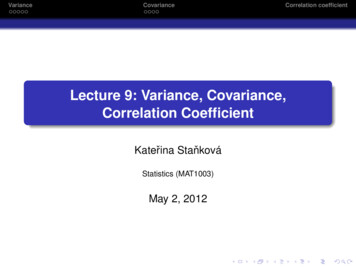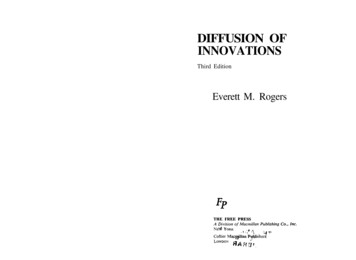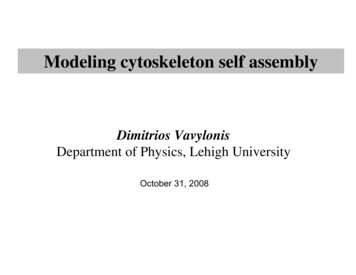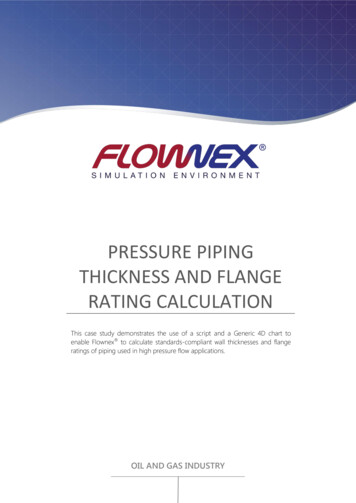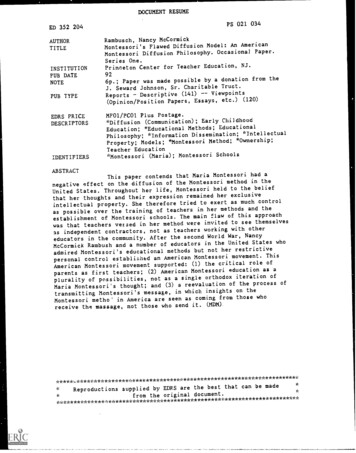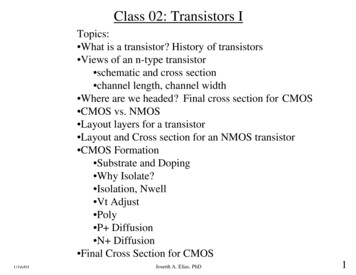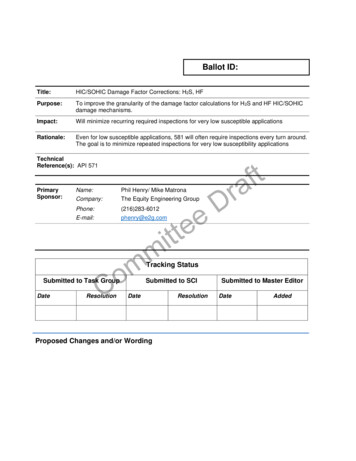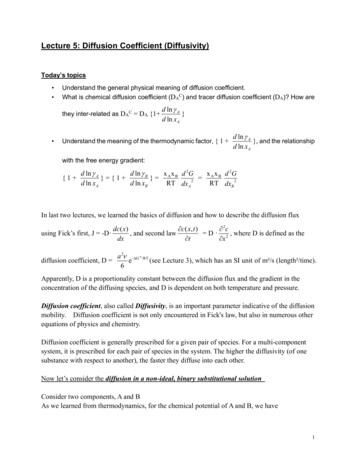
Transcription
Lecture 5: Diffusion Coefficient (Diffusivity)Today’s topics Understand the general physical meaning of diffusion coefficient.What is chemical diffusion coefficient (DAC) and tracer diffusion coefficient (DA)? How arethey inter-related as DAC DA {1 d ln g A}d ln x AUnderstand the meaning of the thermodynamic factor, { 1 d ln g A}, and the relationshipd ln x Awith the free energy gradient:{1 d ln g Ad ln g Bx x d 2Gx A x B d 2G} {1 } A B d ln x Ad ln xBRT dx A 2RT dxB 2In last two lectures, we learned the basics of diffusion and how to describe the diffusion fluxdc( x)¶c( x, t )¶ 2cusing Fick’s first, J -D·, and second law D · 2 , where D is defined as thedx¶t¶xdiffusion coefficient, D a 2n - DG A /RTe(see Lecture 3), which has an SI unit of m²/s (length²/time).6Apparently, D is a proportionality constant between the diffusion flux and the gradient in theconcentration of the diffusing species, and D is dependent on both temperature and pressure.Diffusion coefficient, also called Diffusivity, is an important parameter indicative of the diffusionmobility. Diffusion coefficient is not only encountered in Fick's law, but also in numerous otherequations of physics and chemistry.Diffusion coefficient is generally prescribed for a given pair of species. For a multi-componentsystem, it is prescribed for each pair of species in the system. The higher the diffusivity (of onesubstance with respect to another), the faster they diffuse into each other.Now let’s consider the diffusion in a non-ideal, binary substitutional solutionConsider two components, A and BAs we learned from thermodynamics, for the chemical potential of A and B, we have1
μA μA0 RT ln aA μA0 RT lnγA RT ln x AμB μB0 RT ln aB μB0 RT lnγB RT ln x Bwhere a is the activity, γ is the activity coefficient, and xA and xB is the composition fraction,xA cBcA, xB .c A cBc A cBd µ A dx Adµ A ,dxdx A dxThen,xA cA,c A cBWhere cA and cB are the concentrations of A and B, and cA cB fixeddx Adc A1 ·c A cBdxdxNow,So,d µAdc1dµ A ·· Adxdx A c A cB dx(1)Also, as shown in Eq. (2) of Lecture 3, the Fick’s first law can be written asc ( x ) dµJ -D··RT dxThen, we haveDA d µ A()RTdxSubstituted with Eq. (1), we haveJA cAJA - - -d µ A dc Ac A DA1···RT c A cB dx A dxd µ dc ADA· xA· Adx A dxRTDA dµ A dc A··RT d ln x A dxNow, as shown above,Then, we haveμA μA0 RT lnγA RT lnxAdµ Ad ln g A RT {1 }d ln x Ad ln x A2
Then, JA above can be re-written asJA -DAd ln g A dc A·RT {1 }·d ln x AdxRT -DA {1 -DAC·d ln g A dc A}·d ln x Adxdc AdxWhere DAC DA {1 d ln g A} is defined as the chemical diffusion coefficientd ln x ADA is defined as the self or tracer diffusion coefficientDAC denotes diffusion under a concentration gradientDA denotes diffusion of tracer A (dilute) in uniform concentrationIn dilute solution, γA γH constant,d ln g A 0, then, DAC à DAd ln x Achemical diffusion coefficient (DAC) and tracer diffusion coefficient (DA) are two veryimportant parameters, please make sure you understand them well and not get confused.§Tracer diffusion, which is a spontaneous mixing of molecules taking place in the absence ofconcentration (or chemical potential) gradient. This type of diffusion can be followed using isotopictracers, hence the name. The tracer diffusion is usually assumed to be identicalto self-diffusion (assuming no significant isotopic effect). This diffusion can take place underequilibrium.§Chemical diffusion occurs in a presence of concentration (or chemical potential) gradient and it resultsin net transport of mass. This is the process described by the diffusion equation. This diffusion isalways a non-equilibrium process, increases the system entropy, and brings the system closer toequilibrium.The diffusion coefficients for these two types of diffusion are generally different because the diffusioncoefficient for chemical diffusion is binary and it includes the effects due to the correlation of the movementof the different diffusing species.Within the above relationship, DAC DA {1 d ln g A}d ln x A3
{1 d ln g A} is a thermodynamic factor, and it can be expressed in terms of Gibbs free energy asd ln x Ashown below:Since, G xAμA xBμBWe have, dG xA dμA μAdxA xB dμB μBdxBNow, taking the Gibbs – Duhem equation: xA dμA xB dμB 0We have dG μAdxA μBdxB, differentiation of both sides givesdxd (1 - x A )dG μA μB B μA μB μA - μBdx Adx Adx A μA0 RT lnγA RT ln x A - μB0 - RT lnγB - RT ln x BThen, we have the second order differentiald ln g A RTd ln g B RTd 2G RT RT 2xAxBdx AdxBdx AIt can be re-written as:d ln g Ad ln g Bd 2GxAxB RT { xAxB xAxB xB xA}2dx AdxBdx A RT { 1 xBd ln g Ad ln g B xA}d ln x Ad ln xBNow, taking the Gibbs – Duhem equation:xA dμA xB dμB 00And taking μA μA RT lnγA RT ln xA, μB μB0 RT lnγB RT ln xBWe have, xA dlnγA xB dlnγB 0or, xAd ln g Ad ln g B- xB 0dx AdxB(note: dxA dxB 0)with little re-writing, we haved ln g Ad ln g B d ln x Ad ln xBSo, the above equation can be re-written as (note: xA xB 1)d ln g Ad ln g Bd 2GxAxB RT { 1 } RT { 1 }2d ln x Ad ln xBdx A4
or,d ln g Ad ln g Bx A x B d 2Gx A x B d 2G{1 } {1 } d ln x Ad ln xBRT dx A 2RT dxB 2So, the relationship between chemical diffusion coefficient (DAC) and tracer diffusioncoefficient (DA) can now also be written asDAC DA {1 d ln g Ax x d 2G d 2Gµ} DA A Bd ln x ART dx A 2 dx A 2d ln g Bx A x B d 2G d 2 Gµ DA {1 } DAd ln xBRT dxB 2 dxB 2Please pay attention to the inter-relation above, and not be confused.The above equation implies that the chemical diffusion (under concentration gradient) isproportional to the second order differential of free energy with respect to the composition.Consider a binary solution with a miscibility gap as shown below (top: phase diagram, bottom:free energy curve).5
With regard to the original solution (metastably retained) as quenched (rapidly cooled), the regioninside spinodal is characterized byd 2Gd 2G 022dx AdxBsince DA is always 0, then this means DAC 0That is, if the original solution is cooled inside the spinodal, the chemical diffusion coefficientdC ADAC is less than zero, i.e., a negative diffusion coefficient, as JA - DAC ·, it means the fluxdxof A diffuse up against concentration gradient (though still along chemical potential or freeenergy gradient). This is known as uphill diffusion, which is important for a special phasetransformation, called Spinodal Decomposition (to be taught in details later in Lectures 22-24).6
That is, if the original solution is cooled inside the spinodal, the chemical diffusion coefficient D A C is less than zero, i.e., a negative diffusion coefficient, as J A - D A C · , it means the flux of A diffuse up against concentration gradient (though still along chemical potential or fr


